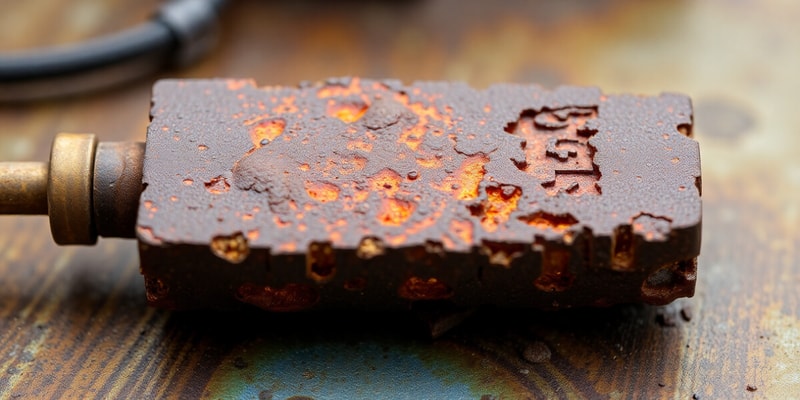Podcast Beta
Questions and Answers
What does rusting primarily involve?
Iron(II) ions are formed during the rusting process.
True
What ion is produced when oxygen is reduced in water during rusting?
hydroxide ion
The ________ acts as the electron acceptor in the rusting process.
Signup and view all the answers
Match the following steps of rusting with their corresponding chemical equations:
Signup and view all the answers
Which factor accelerates the rusting process?
Signup and view all the answers
Rust is specifically defined as iron(II) hydroxide.
Signup and view all the answers
What is the final product of the rusting process?
Signup and view all the answers
Water acts as an ________ in the rusting process.
Signup and view all the answers
What happens to iron(II) hydroxide during rust formation?
Signup and view all the answers
Study Notes
Rusting: An Electrochemical Process
- Rusting is an electrochemical process where iron is oxidized in the presence of oxygen and water.
- Electrons are transferred from iron to oxygen, forming iron oxides (rust).
Chemical Reactions Involved
-
Anode (Oxidation of Iron): Iron atoms lose electrons, forming iron(II) ions:
- Fe(s) → Fe²⁺(aq) + 2e⁻
-
Cathode (Reduction of Oxygen): Oxygen molecules dissolved in water gain electrons, forming hydroxide ions:
- O₂(g) + 2H₂O(l) + 4e⁻ → 4OH⁻(aq)
-
Formation of Iron(II) Hydroxide: Iron(II) ions and hydroxide ions combine to form iron(II) hydroxide:
- Fe²⁺(aq) + 2OH⁻(aq) → Fe(OH)₂(s)
-
Further Oxidation: Iron(II) hydroxide is oxidized by oxygen in the presence of water to form iron(III) oxide hydrate (rust):
- 4Fe(OH)₂(s) + O₂(g) + 2H₂O(l) → 4Fe(OH)₃(s)
- 2Fe(OH)₃(s) → Fe₂O₃.xH₂O(s) + (3-x)H₂O(l) (where x represents the varying degree of hydration)
Key Factors
- Presence of Water: Water acts as an electrolyte, facilitating ion movement and the electrochemical reactions.
- Presence of Oxygen: Oxygen acts as the electron acceptor, driving iron oxidation.
- Electrolytes: Dissolved salts in water increase conductivity, accelerating rusting.
Studying That Suits You
Use AI to generate personalized quizzes and flashcards to suit your learning preferences.
Description
Explore the intricate process of rusting as an electrochemical reaction involving the oxidation of iron. This quiz covers essential chemical reactions, including the formation of iron oxides and the key factors that influence rusting. Test your understanding of the oxidation and reduction processes in the presence of water and oxygen.



